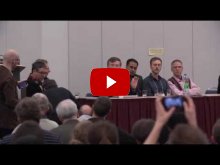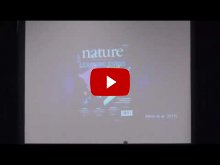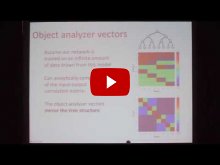Uploaded:
January 28, 2016
Excerpt of Marvin Minsky's talk as part of the Keynote Panel for the MIT150: Brains, Minds and Machines Symposium entitled "The Golden Age: A Look at the Original Roots of Artificial Intelligence, Cognitive Science, and Neuroscience"
Recorded May 3...
Recorded:
Jan 22, 2016
Uploaded:
January 22, 2016
Part of
Computational Tutorials
Speaker(s):
Seth Egger
Introduction to linear dynamical systems, stochastics, and the evolution of probability density, with application to modeling the generation of neural signals.
Taught by: Seth Egger, MIT
Each tutorial consists of a lecture, and then 'office hours'...
Recorded:
Jan 21, 2016
Uploaded:
January 21, 2016
Part of
Computational Tutorials
Speaker(s):
Sam Norman-Haignere
Taught by: Sam Norman-Haignere
Dimensionality Reduction using the method of Independent Components Analysis, and its application to the analysis of fMRI data. Dimensionality Reduction II tutorial from the tutorial series in computational topics for...
Recorded:
Jan 19, 2016
Uploaded:
January 19, 2016
Part of
Computational Tutorials
CBMM Speaker(s):
Emily Mackevicius
Speaker(s):
Ciccarelli
Taught by: Emily Mackevicius and Greg Ciccarelli
Introduction to dimensionality reduction and the methods of Principal Components Analysis and Singular Value Decomposition. Dimensionality Reduction I tutorial from the tutorial series in...
Uploaded:
January 12, 2016
Part of
Computational Tutorials
Cluster computing and OpenMind tutorial from the tutorial series in computational topics for brain and cognitive sciences. Lecture slides, references, exercises, and sign-ups for future tutorials are posted here: https://stellar.mit.edu/S/project/...
Uploaded:
January 12, 2016
Part of
Computational Tutorials
Cluster computing and OpenMind tutorial from the tutorial series in computational topics for brain and cognitive sciences. Lecture slides, references, exercises, and sign-ups for future tutorials are posted here: https://stellar.mit.edu/S/project/...
Uploaded:
December 16, 2015
Scientists have long wondered if the human brain contains neural mechanisms specific to music perception. Now, for the first time, MIT neuroscientists have identified a neural population in the human auditory cortex that responds selectively to...
Uploaded:
December 10, 2015
Part of
NIPS 2015 Symposium: Brains, Minds and Machines
Panel discussion
Uploaded:
December 10, 2015
Part of
NIPS 2015 Symposium: Brains, Minds and Machines
Neuroscience and the Quest for AI
How systems neuroscience can help in the quest for Artificial General Intelligence
Uploaded:
December 10, 2015
Part of
NIPS 2015 Symposium: Brains, Minds and Machines
Towards Glimpses of a New Science of Brains, Minds and Machines:
Weaving Together Physics, Computer Science, and Neurobiology Our neural circuits exploit the laws of physics to perform computations in ways that are fundamentally different from...
Weaving Together Physics, Computer Science, and Neurobiology Our neural circuits exploit the laws of physics to perform computations in ways that are fundamentally different from...

 have an interactive transcript feature enabled, which appears below the video when playing. Viewers can search for keywords in the video or click on any word in the transcript to jump to that point in the video. When searching, a dark bar with white vertical lines appears below the video frame. Each white line is an occurrence of the searched term and can be clicked on to jump to that spot in the video.
have an interactive transcript feature enabled, which appears below the video when playing. Viewers can search for keywords in the video or click on any word in the transcript to jump to that point in the video. When searching, a dark bar with white vertical lines appears below the video frame. Each white line is an occurrence of the searched term and can be clicked on to jump to that spot in the video.



![Embedded thumbnail for Cluster computing and OpenMind [part 1]](https://cbmm.mit.edu/sites/default/files/styles/youtube_thumbnail_220w/public/youtube/QTvNTEh04to.jpg?itok=JNo35sid)
![Embedded thumbnail for Cluster computing and OpenMind [part 2]](https://cbmm.mit.edu/sites/default/files/styles/youtube_thumbnail_220w/public/youtube/w4Fdj9t3xRc.jpg?itok=U1AloQZc)



